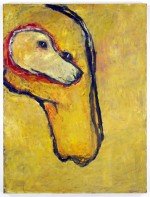Two exhibitions
dal 1/11/2006 al 15/12/2006
Segnalato da
1/11/2006
Two exhibitions
Sperone Westwater, New York
In the new works on canvas and on paper, Susan Rothenberg continues to draw her imagery from her physical surroundings in the New Mexico desert. Horses, dogs, snakes, rabbits and humans are featured, sometimes whole, often as fragments or parts. "1 - Dimensional Labyrinth" is a new work by Jeppe Hein, this constructed labyrinth made of steel and mirrors continues his ongoing interest in sculpture as an expanded field of social interaction.

Susan Rothenberg
Sperone Westwater is pleased to announce an exhibition of new paintings by Susan Rothenberg.
In these new works on canvas and on paper, Rothenberg continues to draw her imagery from her physical surroundings in the New Mexico desert. Horses, dogs, snakes, rabbits and humans are featured, sometimes whole, often as fragments or parts. The works on view have richly textured surfaces and expand the artist’s palette of bold purples, yellows, and reds. Sixteen years have passed since Rothenberg moved to New Mexico, and these paintings strongly demonstrate that the landscape and world of the desert, once foreign territory for the artist, have become more familiar.
As Robert Storr writes, “the image in a painting by Susan Rothenberg is the last stage of an incremental process of statement, revision, cancellation, and restatement." The artist herself has said: “I make messy paintings that often have an image in them that you may or may not recognize." Indeed, Rothenberg’s active gestural brushwork pushes the boundary between figural representation and abstraction and the results are dynamic paintings that simultaneously deny narrative while at the same time referencing scenes of life’s small dramas.
In her canvases, Rothenberg subverts the traditional hierarchies of people and animals— here, paws are nearly as large as arms, and disembodied legs, heads and animal parts make familiar forms appear strange. A motif of masks appears, exemplifying the visceral tension between the lyrical and the grotesque in Rothenberg’s work. Simultaneously intuitive and emotional, these new paintings demonstrate the artist’s extraordinary ability to challenge and extend painterly conventions with her exploration of light, color and movement.
Rothenberg’s first solo exhibition in New York in 1975, consisting of three major horse paintings, was heralded for introducing imagery into minimalist abstraction and bringing a new sensitivity to figuration. Since then, Rothenberg has had numerous solo exhibitions and her work has been exhibited extensively throughout the United States and abroad. Her work is in the collections of over forty major public institutions worldwide. Recent important exhibitions include a retrospective at the Albright-Knox Art Gallery in Buffalo, New York that traveled to Washington, D.C., St. Louis, Chicago, and Seattle (1992); a retrospective at the Museo de Arte Contempora'neo in Monterrey, Mexico (1996); a show of paintings from the nineties at The Museum of Fine Arts, Boston (1999), and an exhibition of drawings and prints at the Museum of Art at Cornell University that traveled to The Contemporary Museum in Honolulu, and the Museum of Fine Arts, Santa Fe (1998-99). Recently, Rothenberg’s work was included in “Contemporary Voices: Works from the UBS Art Collection" (2005) and “Against the Grain: Contemporary Art from the Edward R. Broida Collection," (2006), both at The Museum of Modern Art, New York, which has significant holdings of Rothenberg’s work on canvas and on paper in its permanent collection.
A catalogue with full-page color reproductions accompanies the exhibition.
*****************
Jeppe Hein (Terrazzo Gallery)
Sperone Westwater is pleased to present an installation of Danish artist Jeppe Hein’s “1 - Dimensional Labyrinth" (2006). A new work by the artist, this constructed labyrinth made of steel and mirrors continues Hein’s ongoing interest in sculpture as an expanded field of social interaction.
Through his innovative installations of cubes, balls and labyrinths, Hein articulates a dialogue between the work itself, the person encountering it and the gallery space in which it is sited. Works of this kind imply a wry relationship both to the Minimalist sculpture of the 1960s and to those forms of institutional critique that sought to question the authority of the museum or gallery space. Yet Hein’s practice does not really fit either tradition - the mode of address and idea of wonder present in his work are at odds with, for example, phenomenological interpretations of Minimalist sculpture, in which the viewer participated in the work but as a relatively abstract presence. For Hein, the viewer is a very literal participant who acts as a trigger for the work and becomes involved, both conceptually and physically, in the carefully calculated structures the artist creates. With “1-Dimensional Labyrinth," as with his previous works, Hein calls into question traditional perceptions and functions of art, creating a work that can only be experienced through the viewer’s participation.
According to Francesco Bonami, “we could say that Hein’s work is about feelings, a sort of mental sculpture that has both a life of its own and a life shared by the viewer. It happens sometimes that the users of Hein’s work don’t even know what the work is about, actually they don’t even realize it’s a work of art." Hein’s work deals in oppositions, at once overtly unnatural while at the same time dealing with nature on a very subtle level. Entering and experiencing the artist’s work poses a challenge not to the viewer’s intellect, but rather to his physical body and psychology.
Born in Copenhagen in 1977, Hein currently lives and works in Berlin. His work has been shown at many major museums worldwide including in solo exhibitions at the Centre Georges Pompidou, Paris, Ludwig Forum fur Internationale Kunst, Aachen, Fundacio' La Caixa, Barcelona, and capcMuse'e d`art contemporain, Bordeaux, and in group shows at the Museum of Contemporary Art, Los Angeles, and the MCA, Chicago, among others.
For more information as well as photographic images, please contact Molly Epstein at Sperone Westwater at (212) 999-7337.
Sperone Westwater
415 West 13 Street - New York



